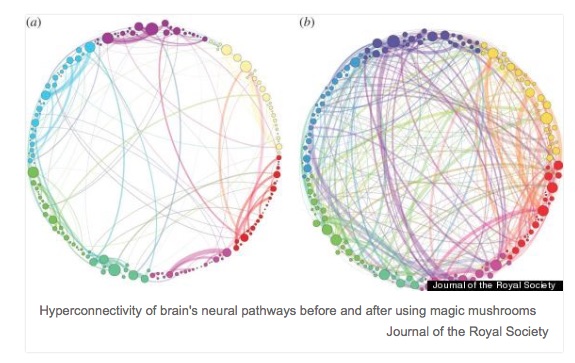Psychedelics and Mystical Experience: A catalyst for healing in contemporary psychedelic research
It is well-established that mystical experiences have historically played a pivotal role in indigenous shamanism and world religions (the miracles surrounding Moses’ Ten Commandments and Jesus’ baptism by John). What is less well-known and quite unexpected is the discovery that mystical experiences are the catalyst for healing in contemporary psychedelic research.

Both the Johns Hopkins and NYU studies on the impact of psilocybin on cancer patients found that “In both trials, the intensity of the mystical experience described by patients correlated with the degree to which their depression and anxiety decreased.”
In other words, researchers have predictably occasioned mystical experiences –faith-based “flights of the soul” traditionally thought to be beyond the scope of empirical science – in clinical settings by administering high-dose synthetic psilocybin. Furthermore, it turns out that these experiences hold the key to positive patient outcomes in psychedelic-assisted psychotherapy.
Let this enigma sink in for a moment.
Mystical Experience Questionnaire
Our understanding of the five common elements in mystical experience is originally based on the insights of William James (The Varieties of Religious Experience, 1902) and Walter T. Stace (Mysticism and Philosophy, 1960). These elements were incorporated into a 30-question operational definition of mysticism, the Mystical Experience Questionnaire (MEQ30) utilized in the Johns Hopkins psilocybin studies.
The five common elements of mystical experience are:
—Unity/Sacredness – deep sense of unity with all of existence.
—Positive Mood/Ecstasy – deeply felt sense of well-being.
—Time Transcendence/Eternity – entering a timeless dimension.
—Authoritative/True Self – understanding one’s authentic self.
—Ineffable/Indescribable – difficult to put into words.
Psychedelic-Assisted Psychotherapy
Beginning in 2006, Johns Hopkins School of Medicine has been conducting the first federally-approved psychedelic research since the 1970s War on Drugs, administering psilocybin to human subjects including studies of personality changes and of psychedelic therapy for treating tobacco/nicotine addiction and cancer-related distress.
In 2016, Johns Hopkins undertook the largest ever study of psilocybin in treating chronic depression and anxiety among patients with life-threatening cancers. In this randomized, double-blind, cross-over trial, 51 patients were given a low placebo-like dose versus a high dose in two sessions with a six-month follow up.
In a Journal of Psychopharmacology article, Roland R. Griffiths, known as the grandfather of the Psychedelic Renaissance, and colleagues report that “High-dose psilocybin produced large decreases in clinician- and self-rated measures of depressed mood and anxiety, along with increases in quality of life, life meaning, and optimism, and decreases in death anxiety.”
Some 70% of the cancer patients rated the high-dose psilocybin session as among the top five “most meaningful” and “spiritually significant” life experiences. In addition, their post-session mystical experience scores served as statistically significant predictors of therapeutic efficiency in reducing anxiety and depression.
The daughter of one study participant noted that “This opportunity allowed my dad to have vigor in his last couple of weeks of life — vigor that one would think a dying man could not possibly demonstrate. His experience gave my father peace. His peace gives me strength.”
These outcomes prompted Griffiths to observe that “It’s very common for people who have profound mystical-type experiences to report very positive changes in attitudes about themselves, their lives, and their relationships with others”and to exclaim that “As a scientific phenomenon, if you can create a condition in which 70% of the subjects achieve positive, lasting results… in one or two sessions!”
Inner Self-Healing Intelligence
This research confirms that mystical experience can alleviate anxiety and depression. “How” this healing takes place is the theoretical Holy Grail of the new science of psychedelics. Griffiths concludes that “the psilocybin experience enables a sense of deeper meaning, and an understanding that in the largest frame everything is fine and that there is nothing to be fearful of.”
How the brain expands from normal consciousness to encompass this “largest frame” is visually shown by Carhart-Harris’s magnetic resonance imaging (MRI) of the brain’s neural pathways before and after ingesting psilocybin mushrooms. Psychedelics allow us to leave the “brain’s default-mode network,” the brain’s everyday information highway, and to travel into areas of the mind only available in expanded states of consciousness, clearing the way for mystical experience.
Brain’s Neural Pathways: Before and After Magic Mushrooms
Mystical experiences arise when the doors of perception are flung wide open so that the spiritual self can surface from the depths of the psyche, empowering us to heal and understand that in the cosmic scheme of things “all is well.” As the psychiatrist who developed psychedelic psychotherapy in the 1950s, Stanislav Grof has guided over 4,500 LSD sessions. Based on his unparalleled experience with LSD and encyclopedic knowledge of the psychedelic literature, Grof observes that “Entering these [holotropic, transpersonal, mystical] states activate an inner self-healing intelligence, which automatically guides the process to unconscious material that has a strong emotional charge and is close to the threshold of consciousness. It then spontaneously brings this material to the surface for processing.”





